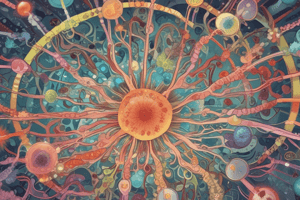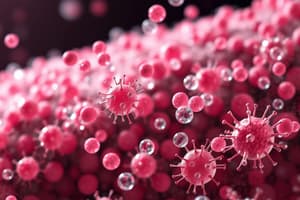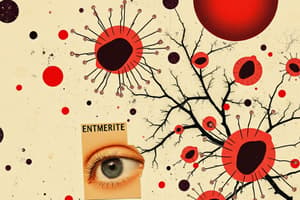Podcast
Questions and Answers
What are the two main types of chains found in immunoglobulin proteins?
What are the two main types of chains found in immunoglobulin proteins?
- Hinge and stem chains
- Alpha and beta chains
- Variable and constant chains
- Heavy and light chains (correct)
Which regions of immunoglobulin proteins are responsible for binding to antigens?
Which regions of immunoglobulin proteins are responsible for binding to antigens?
- Hinge regions
- Variable regions (correct)
- Stem regions
- Constant regions
What is the role of Complementary Determining Regions (CDRs) in immunoglobulin proteins?
What is the role of Complementary Determining Regions (CDRs) in immunoglobulin proteins?
- To facilitate the binding of the immunoglobulin to B lymphocytes
- To allow for specificity in antigen recognition (correct)
- To enhance the stability of the immunoglobulin structure
- To regulate the entire immune response
During T cell maturation, which components are rearranged in a precise order?
During T cell maturation, which components are rearranged in a precise order?
Which immunoglobulin is co-expressed alongside IgD in B lymphocytes?
Which immunoglobulin is co-expressed alongside IgD in B lymphocytes?
What is the primary role of B lymphocytes?
What is the primary role of B lymphocytes?
What is the function of Helper T lymphocytes (T-CD4)?
What is the function of Helper T lymphocytes (T-CD4)?
Which lymphocyte is primarily responsible for killing infected cells?
Which lymphocyte is primarily responsible for killing infected cells?
Which step in lymphocyte development involves the elimination of cells that strongly recognize self antigens?
Which step in lymphocyte development involves the elimination of cells that strongly recognize self antigens?
What do mature B cells differentiate into?
What do mature B cells differentiate into?
Which function is associated with Regulatory T lymphocytes (T-Reg)?
Which function is associated with Regulatory T lymphocytes (T-Reg)?
What characterizes the sequential rearrangement of antigen receptor genes in lymphocyte development?
What characterizes the sequential rearrangement of antigen receptor genes in lymphocyte development?
Which type of lymphocyte is involved in both humoral and cellular immunity?
Which type of lymphocyte is involved in both humoral and cellular immunity?
What is the first checkpoint in lymphocyte development?
What is the first checkpoint in lymphocyte development?
Which statement best describes positive selection in B cell development?
Which statement best describes positive selection in B cell development?
During the negative selection process, what happens to developing lymphocytes?
During the negative selection process, what happens to developing lymphocytes?
What criteria allow developing B and T cells to survive after expressing complete antigen receptors?
What criteria allow developing B and T cells to survive after expressing complete antigen receptors?
What role do pre-antigen receptors play in B cell development?
What role do pre-antigen receptors play in B cell development?
What type of selection is associated with preserving B cell subsets?
What type of selection is associated with preserving B cell subsets?
What occurs after the assembly of a complete receptor in lymphocyte maturation?
What occurs after the assembly of a complete receptor in lymphocyte maturation?
Which of the following is NOT a function of antigen receptors during lymphocyte maturation?
Which of the following is NOT a function of antigen receptors during lymphocyte maturation?
What is the significant outcome of successful receptor assembly in lymphocyte development?
What is the significant outcome of successful receptor assembly in lymphocyte development?
Which process is primarily responsible for eliminating cells that respond to self-antigens?
Which process is primarily responsible for eliminating cells that respond to self-antigens?
What role do hematopoietic stem cells play in the development of B cells?
What role do hematopoietic stem cells play in the development of B cells?
Which transcription factors are involved in inducing genes required for B cell development?
Which transcription factors are involved in inducing genes required for B cell development?
What mechanism primarily functions to silence gene expression in lymphocyte development?
What mechanism primarily functions to silence gene expression in lymphocyte development?
What is the consequence of deleting Dicer in the B cell lineage?
What is the consequence of deleting Dicer in the B cell lineage?
Which of the following histone modifications may lead to the activation of genes?
Which of the following histone modifications may lead to the activation of genes?
What is the primary function of microRNAs in lymphocyte development?
What is the primary function of microRNAs in lymphocyte development?
Which protein modification is required for chromatin remodeling in lymphocyte development?
Which protein modification is required for chromatin remodeling in lymphocyte development?
Which B cell receptor is primarily found in the follicular B cell population?
Which B cell receptor is primarily found in the follicular B cell population?
What is a function of the Rag-1 and Rag-2 proteins in B cell development?
What is a function of the Rag-1 and Rag-2 proteins in B cell development?
Which type of stem cells gives rise to distinct B and T cell lineages?
Which type of stem cells gives rise to distinct B and T cell lineages?
Flashcards are hidden until you start studying
Study Notes
Lymphocytes and Immune Response
- Lymphocytes are responsible for specific recognition and response to foreign antigens, mediating both humoral and cellular immunity.
- B lymphocytes produce antibodies, neutralizing microbes, activating phagocytosis, and complement activation.
- Helper T lymphocytes (T-CD4) activate macrophages, promote inflammation, and stimulate the proliferation and differentiation of T and B lymphocytes.
- Cytotoxic T lymphocytes (T-CD8) eliminate infected cells by killing them.
- Regulatory T lymphocytes (T-Reg) suppress the immune response, preventing excessive or inappropriate immune reactions.
- Natural Killer (NK) cells also kill infected cells, serving as part of the innate immune system.
Sequential Events in Lymphocyte Development
- Commitment of progenitor cells to either the B or T lymphoid lineage.
- Proliferation of progenitors and immature committed cells, expanding the pool of cells capable of becoming functional lymphocytes.
- Rearrangement of antigen receptor genes, leading to the expression of antigen receptor proteins.
- Selection events that preserve cells with functional antigen receptors and eliminate those that recognize self-antigens.
- Differentiation of B and T cells into specialized subpopulations, with B cells developing into follicular, marginal zone, and B-1 cells, and T cells differentiating into CD4+ and CD8+ αβ T lymphocytes, natural killer T (NKT) cells, and MAIT cells.
B Lymphocyte Development
- B cells specialize in antibody production.
- The body maintains a limited pool of B cells with diverse antibody specificities, expanding and contracting specific subpopulations as needed.
- Hematopoietic stem cells in the bone marrow provide a constant supply of new B cells.
- Crucial transcription factors (EBF, E2A, and Pax-5) regulate B cell development, inducing the expression of genes essential for B cell function, including those for the pre-B cell receptor, B cell receptor, IgM and IgD, and signaling proteins.
Epigenetic Mechanisms Regulating Lymphocyte Development
- DNA methylation, typically silencing gene expression.
- Histone modifications, such as acetylation, methylation, and ubiquitination, affecting gene activity depending on the specific modification.
- Chromatin remodeling by specialized protein machines called remodeling complexes, influencing gene expression by either enhancing or suppressing it.
- Noncoding RNAs, silencing gene expression.
Selection Processes Shaping B Lymphocyte Repertoires
- Checkpoints during lymphocyte development evaluate cells, allowing only those that have successfully completed preceding steps to mature.
- The pre-antigen receptor serves as the first checkpoint, ensuring the successful production of at least one polypeptide chain and the assembly of a complete receptor.
- Developing B and T cells express complete antigen receptors, undergoing selection based on what these receptors recognize.
- Cells with functional antigen receptors are preserved, while those strongly recognizing self-structures are eliminated.
Stages of B Lymphocyte Maturation
- Pro-B cell: Early stage of development characterized by the rearrangement of heavy chain genes.
- Pre-B cell: Production of the pre-B cell receptor, ensuring the success of heavy chain rearrangement.
- Immature B cell: Rearrangement of light chain genes and expression of the B cell receptor containing both heavy and light chains.
- Mature B cell: Fully functional B cell capable of recognizing and responding to specific antigens.
Immunoglobulin Expression during B Lymphocyte Maturation
- Pro-B cell: No immunoglobulin expression.
- Pre-B cell: Expression of a pre-B cell receptor containing only the μ heavy chain.
- Immature B cell: Expression of IgM B cell receptor.
- Mature B cell: Expression of both IgM and IgD B cell receptors.
Immunoglobulin (Antibody) Structure
- Variable region: Recognizes and binds to specific antigens.
- Constant region: Determines the class of antibody and interacts with effector molecules.
- Hinge region: Provides flexibility for antigen binding.
- Stem region: Involved in effector functions.
- Heavy chain: Larger chain responsible for antibody class.
- Light chain: Smaller chain also contributing to antigen binding.
Monoclonal Antibodies in Clinical Use
- These are antibodies produced by identical immune cells, all clones of a single parent cell, exhibiting high specificity and homogeneity.
- They have revolutionized medicine, offering targeted therapies for various diseases, including cancer, autoimmune disorders, and infectious diseases.
Studying That Suits You
Use AI to generate personalized quizzes and flashcards to suit your learning preferences.




